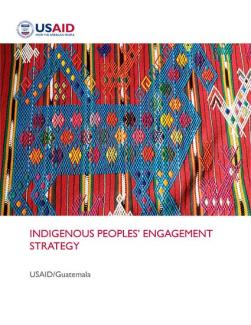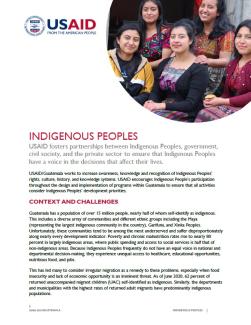
USAID fosters partnerships between Indigenous Peoples, government, civil society, and the private sector to ensure that Indigenous Peoples have a voice in the decisions that affect their lives.
USAID/Guatemala works to increase awareness, knowledge and recognition of Indigenous Peoples’ rights, culture, history, and knowledge systems. USAID encourages Indigenous People’s participation throughout the design and implementation of programs within Guatemala to ensure that all activities consider Indigenous Peoples’ development priorities.
CONTEXT AND CHALLENGES
Guatemala has a population of over 15 million people, nearly half of whom self-identify as indigenous. This includes a diverse array of communities and different ethnic groups including the Maya (representing the largest indigenous community in the country), Garifuna, and Xinka Peoples. Unfortunately, these communities tend to be among the most underserved and suffer disproportionately along nearly every development indicator. Poverty and chronic malnutrition rates rise to nearly 80 percent in largely indigenous areas, where public spending and access to social services is half that of non-indigenous areas. Because Indigenous Peoples frequently do not have an equal voice in national and departmental decision-making, they experience unequal access to healthcare, educational opportunities, nutritious food, and jobs.
This has led many to consider irregular migration as a remedy to these problems, especially when food insecurity and lack of economic opportunity is an imminent threat. As of June 2020, 62 percent of returned unaccompanied migrant children (UAC) self-identified as indigenous. Similarly, the departments and municipalities with the highest rates of returned adult migrants have predominantly indigenous populations.
ENGAGING WITH INDIGENOUS PEOPLES
Engaging Indigenous People as meaningful partners in development enhances their ability to promote their rights, determine their own priorities, and advance their self-reliance. USAID seeks to empower Indigenous Peoples, enabling them to participate in key decision-making spaces at the community, municipal, regional, and national levels.
In addition to strengthening the political participation of Indigenous People, USAID activities also support indigenous leaders to design sound development plans for their communities, improve health, water, and sanitation services in indigenous communities, and expand education and economic opportunities for indigenous youth. USAID also works with indigenous communities to develop community action plans that reduce conflict and strengthen social cohesion.
INDIGENOUS PEOPLE’S ENGAGEMENT STRATEGY
USAID’s Indigenous People’s Engagement Strategy in Guatemala seeks to bridge Indigenous Peoples’ knowledge systems with national systems by closely coordinating efforts with indigenous entities, integrating their perspectives and priorities into programs. The Strategy provides a roadmap to improve development outcomes by addressing the inequities historically suffered by Indigenous Peoples, while elevating their contributions and knowledge within society. USAID partners with Indigenous Peoples to understand their development priorities and define strategies to respond to those challenges, ensuring their participation and the fulfillment of their rights. USAID also provides professional development opportunities to the indigenous leaders with an emphasis on youth and women.
PARTNERSHIP THROUGH ‘LA RUTA’
USAID supports the Government of Guatemala’s ‘La Ruta’ initiative, which fosters dialogue between Indigenous Peoples in the Western Highlands and the Guatemalan central government to increase service delivery and reduce social conflict. Addressing the development priorities of these populations will improve public services, promote economic opportunities through private sector engagement, and increase security, all of which will reduce illegal immigration.


